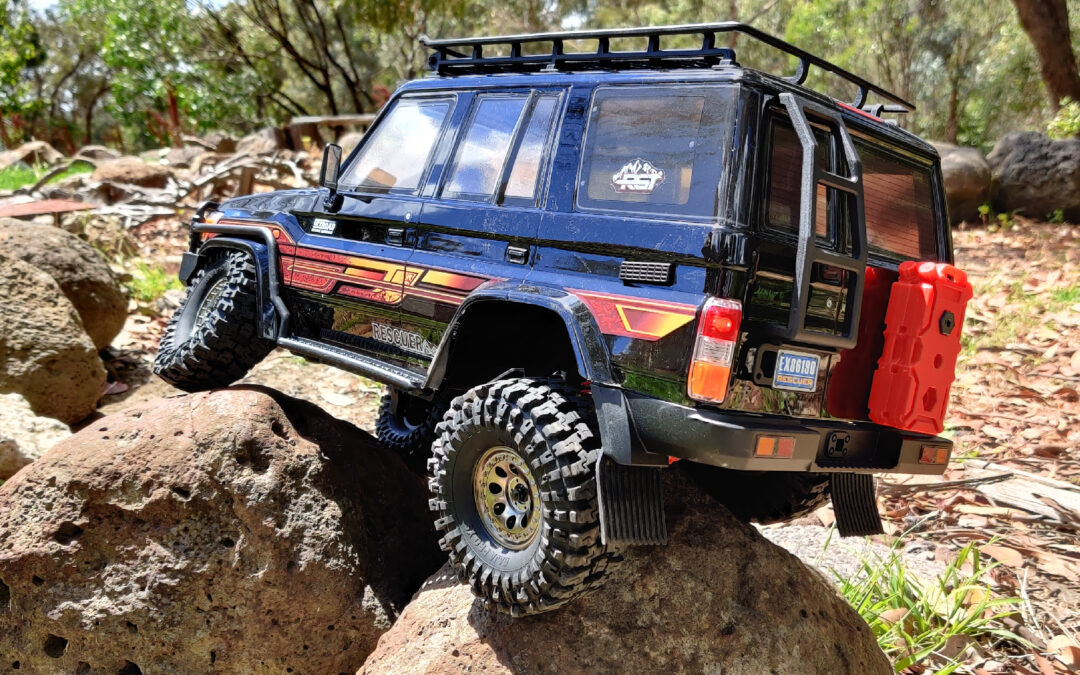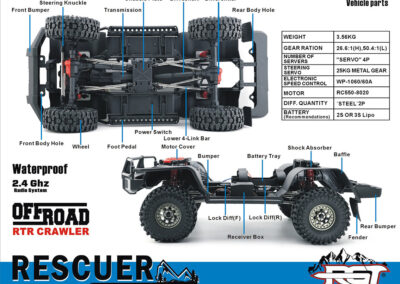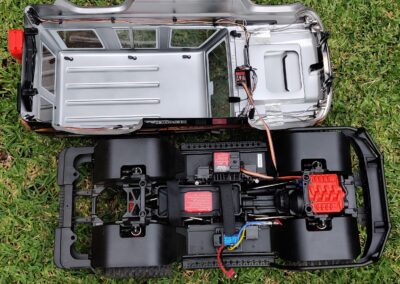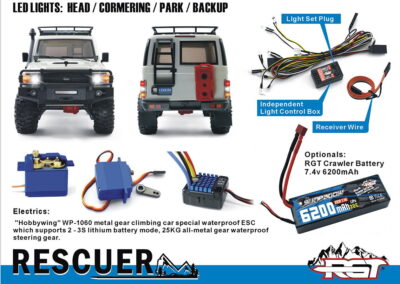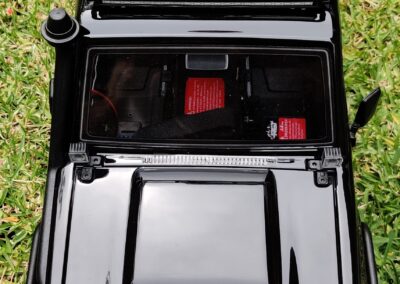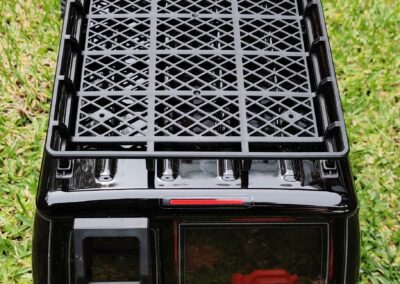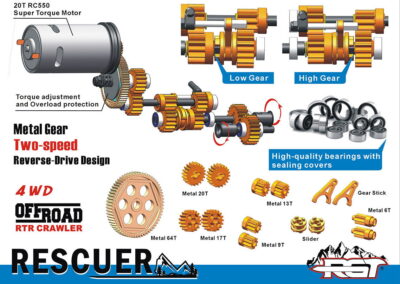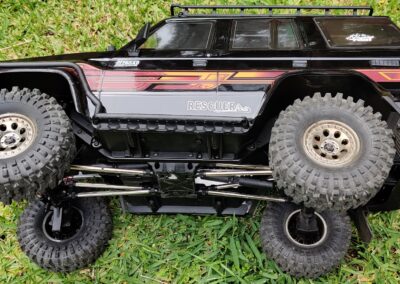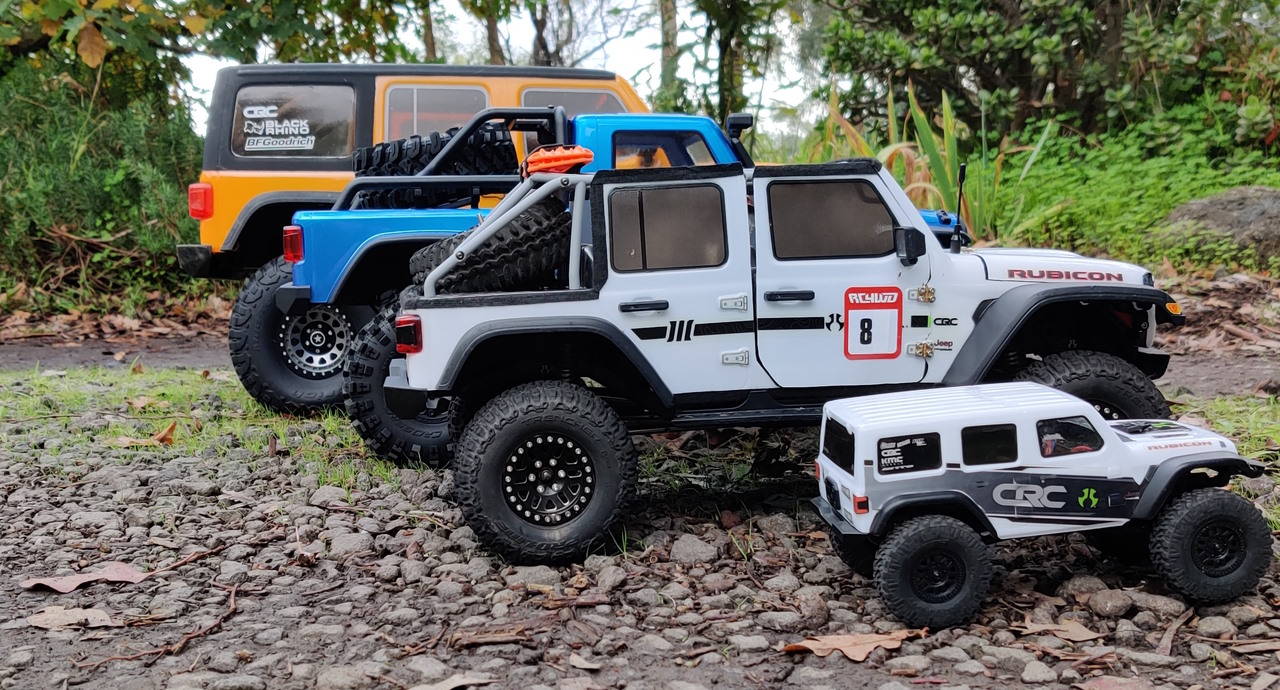Bells & Whistles
The new RGT Rescuer (EX86190) is RGT’s latest and greatest ‘full-fat’ RC rock crawler. A Ready-To-Run (RTR) model, it features 2-speed transmission, portal axles and front & rear locking differentials, switchable lights and a highly detailed body. Does this LC76 model have what it takes to be a worthy alternative to the venerable Traxxas TRX4? Let’s find out!
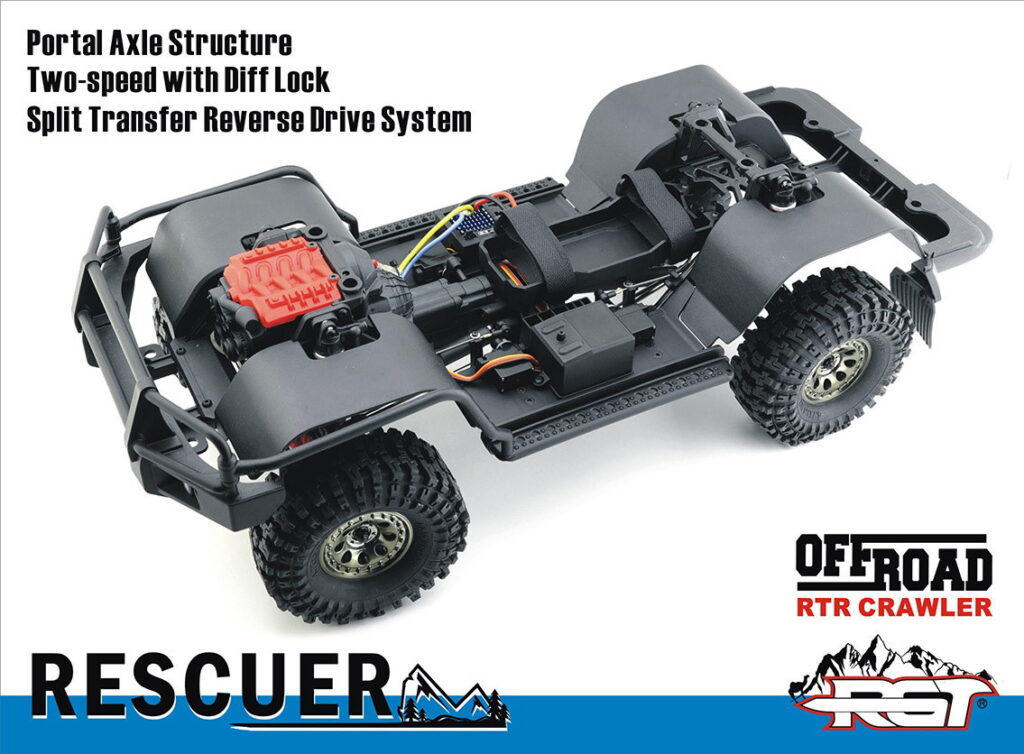
What’s This All About?
The RGT Rescuer is a 1:10 scale RC rock crawler. It has a 324mm wheelbase (or 12.76”) and is something of a special vehicle. Scale details make for a very pretty body while a host of technical goodness resides underneath, including remote-locking diffs, portal axles, two-speed transmission and a full-function light kit! In this review we’ll look at both the features and discuss performance characteristics – and there’s our two-part video review at the end of the article as well, so you can see this machine in action!
The short version is it’s attractive and it is an epic trail machine. For more detail about it’s technical function, reliability, rock crawling ability and overall quality, join us as we take a deeper look at this budget machine with a big-name spec sheet!
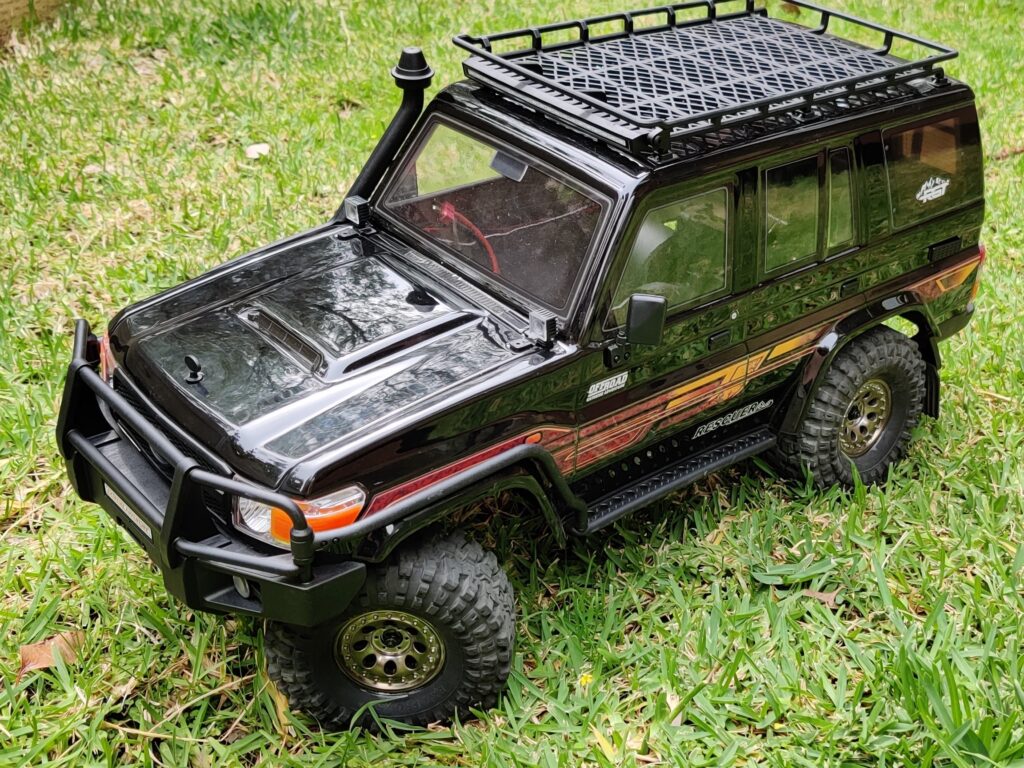
Impressive Body Details
The RGT Rescuer breaks with the current trend of issuing American SUV bodies. No Jeep or Ford truck here! Instead, the EX86190 ships with what appears to be a Toyota Landcruiser 76 Series body. We say ‘appears to be’ because there is no branding on the body. The included sticker sheet has the name ‘TOYOTA’ twice on some designs, but there is no logo of the company nor of the ‘Landcruiser’ badging that is standard on all such full-size vehicles.
This begs the question, is this an unlicensed copy? It appears so – we’ve reached out to RGT about it but have yet to get a response. Intellectual property issue aside, it’s a lovely body indeed. It’s available in Black, White and Desert Yellow colors (shown on store page).
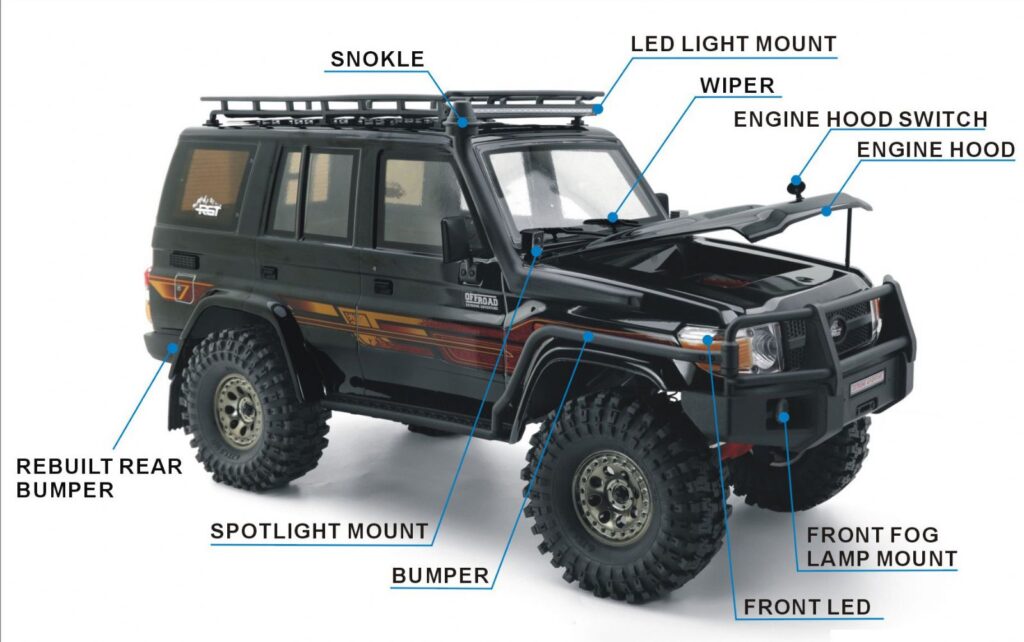
Body: All The Trimmings
As well as featuring 4 hidden body mount points (in front and rear bumper), there is detailed plastic trim adorning the body, front to rear:
- Full-face bull-bar with integrated winch fairlead and fog lights (no LEDs installed);
- Scrub bars that connect from bull-bar to sliders/side steps;
- Side steps in the form of steel bar rock sliders;
- Toyota-shaped logo (sans-logo itself) on the hood which doubles as a latch to open the hood;
- Plastic front grille with Toyota-shaped logo in center (again, sans-logo);
- Light buckets front and rear (LEDs installed – more on that in a moment);
- Spotlights mounted at the base of the A-pillars (no LEDs installed);
- Wipers (1 for the rear, 2 for the front – DIY install);
- Scale snorkel and pre-filter;
- Hinged side mirrors with metallic, reflective stickers for added realism;
- Door handles on all 5 doors;
- Rear panel air vent, matching the configuration of the full-size 76 Series vehicle;
- Rear bumper with integrated rubber mud flaps (removable);
- Full-length roof rack with integrated faux light bar;
- Rear ladder for roof rack access; and,
- A set of red fuel containers with integrated spare wheel holder (bracket included, but no spare wheel).
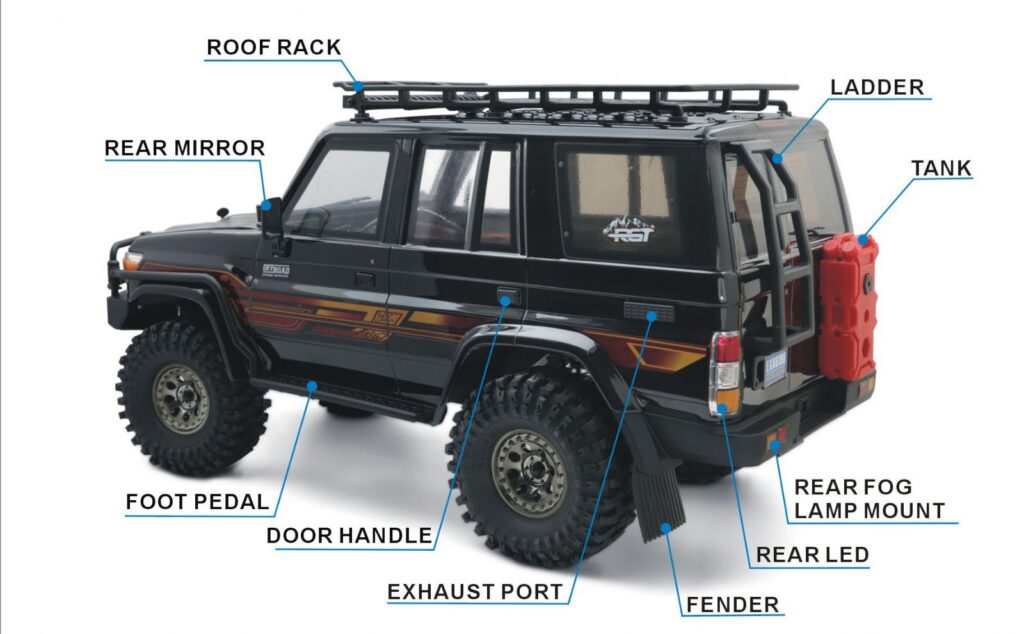
Body: Polycarbonate Detail
As well as all that extra goodness, the polycarbonate body itself is impressively detailed. The mould is a high-resolution reproduction of the full-size 4WD wagon it models. The hood opens to reveal a red engine cover, which hides the motor and servo. The windows and lines on the body are all correctly proportioned and to finish it all off, the included livery has gaps where the door gaps would be in real life (if they actually opened). This all adds up to a great looking body!
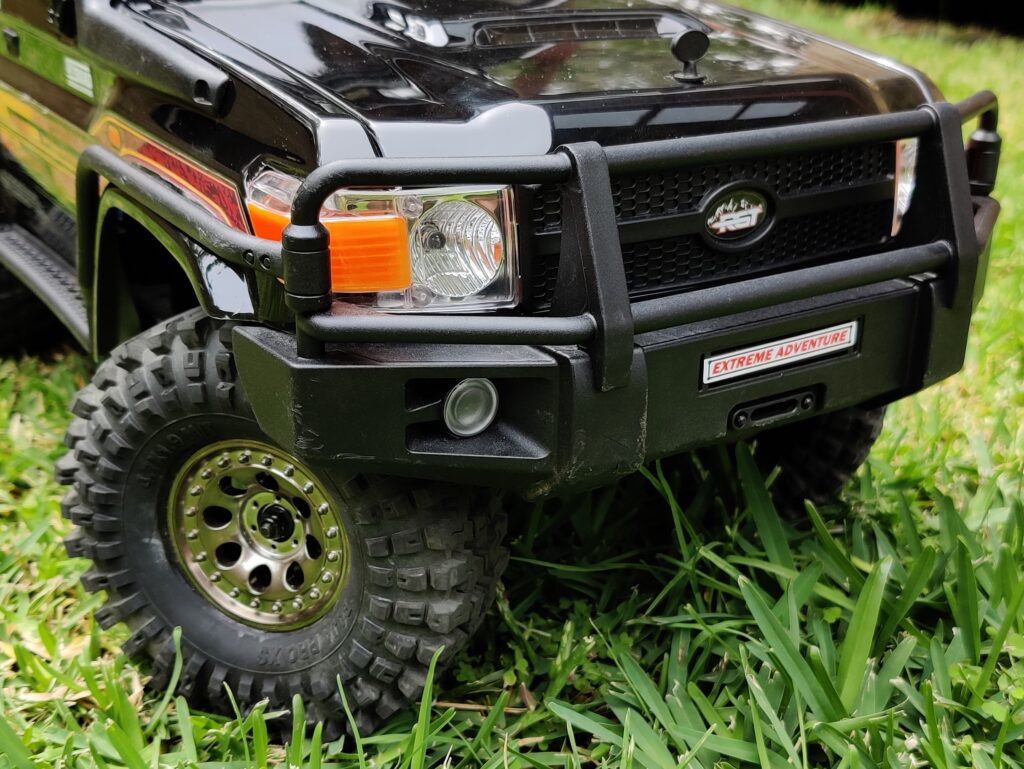
Wheels & Tires
The included wheels are a standard 1.9” plastic rim with a smoked-chrome finish. The tires are glued rather than beadlocked. Some compromise is acceptable with a vehicle like this, where you have all the features and yet a lower price than the competition. The tires are good enough that this isn’t a big deal, and later on you may choose to buy any weighted 1.9” bead-lock wheel when you’re ready for new tires.
The tires themselves are labelled ‘BAJA PRO XS’ and ‘4.7 X 1.9 M/T’ on the sidewalls. It feels like there’s a single-stage, open-cell foam donut inside each tire. We found the rubber itself was soft enough that it compressed and deformed a little on rocks. The wheels are vented and there’s sufficient tread that they do very well in mud, poorly on sand, and reasonably on rock. Overall, we’d rate these wheels and tires as ‘good enough’ for crawling and ‘very good’ for trail and general use. They certainly hook up on gravel!
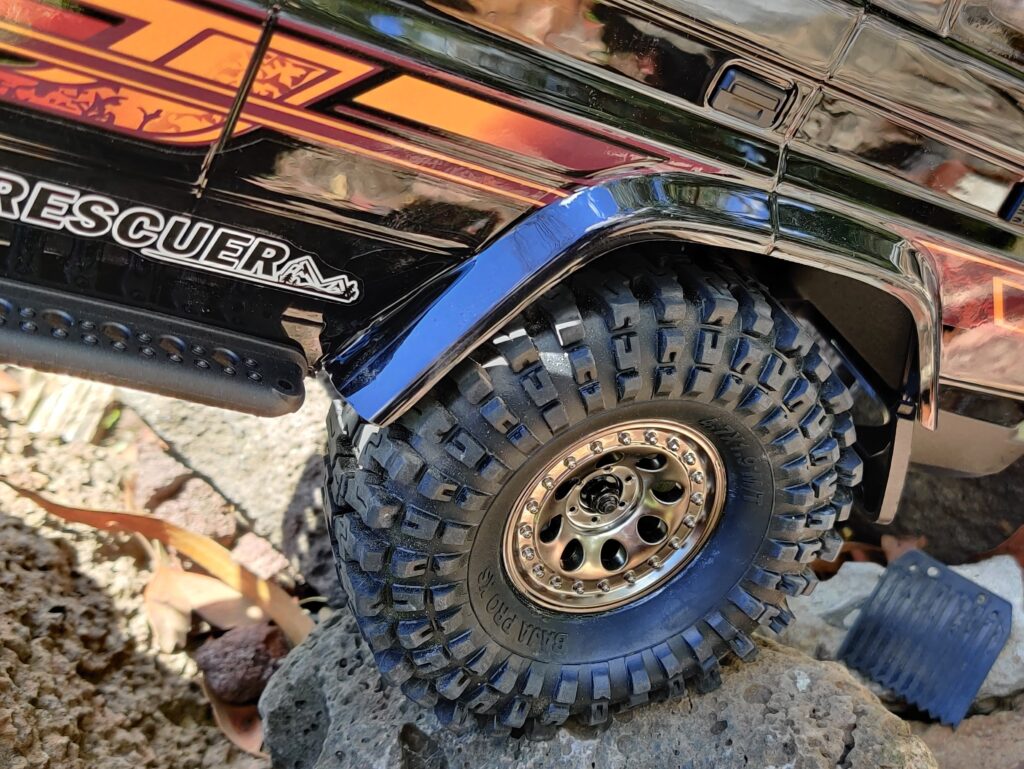
Suspension & Geometry
Suspension duties are handled by dual-stage coil-over springs around plastic shocks. They feature adjustable collars and a small, secondary reservoir with internal spring. This secondary reservoir reportedly delivers longer shock life, though even standard shocks should be well-able to outlast the rest of the vehicle. They’re attractive units and in our use on trails and rocks, worked as expected. They are softly sprung and lightly damped, so overall you get what we’d call a ‘scale’ amount of body roll. It works well on this vehicle.
Vehicle links are stainless steel, with a 3-link and panhard arrangement up-front and a standard 4-link in the rear. All links are 5mm diameter and rod ends have stainless steel ball ends. It’s a time-tested layout and everything moves freely. The result is a plush ride and a decent amount of articulation.
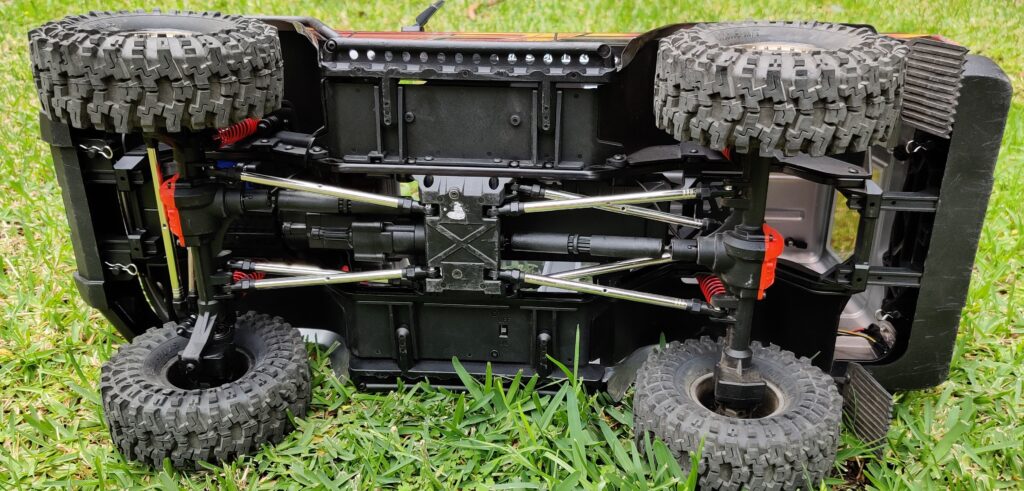
RGT Rescuer Dimensions
As well as the aforementioned 324mm wheelbase (12.76”), the vehicle overall is 582mm long (22.9”) and 248mm wide (9.77”). Including the 25mm roof-rack, the entire vehicle is 300mm tall (11.82”).
Diff-to-ground clearance is 54mm (2.12”) while breakover height (skid plate to ground) is 70mm (2.76”). Approach angle is 53.5 degrees and departure angle is 40 degrees. Tires have an outer diameter of 4.72” (or 120mm).
The model weighs 3.56kg (7.85lb) without battery.
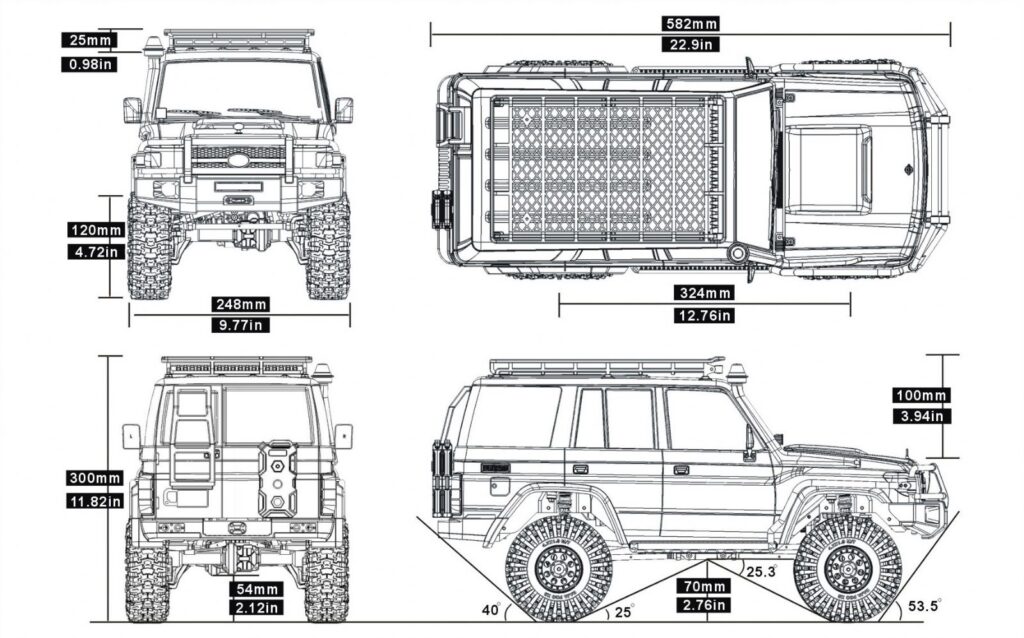
EX86190 Transmission
The RGT Rescuer transmission has several interesting features.
Transmission: Two-Speed
For starters, there’s an integrated two-speed shifter with a decent jump in speed between low and high gear. The low gear ratio is 26.6:1 whilst the high gear ratio is 50.4:1. That’s a very useable gap between high and low – perfect!
Transmission: Metal Gears & Slipper Clutch
Next, all gears are metal, even including the 64T spur gear. This can mean a noisier transmission, but certainly, it’s very strong. (Update: after some months of driving, no breakages so far! We discuss gear material in this little update post). There is an integrated slipper clutch that is done up quite tightly from factory. This suits some drivers (including us), but for younger drivers you may want to loosen it an eighth of a turn to help protect the motor and driveshafts from abusive driving.
Transmission: Appropriate Motor
The motor is a 20T RC550 unit. This is a slightly slower motor than the 17T 550 Titan that Traxxas includes with their TRX4 and TRX6. However, the compromise of slightly lower punch and top speed for lower power draw, lower heat and longer runtimes is a perfect trade-off on the Rescuer. Our personal preference with the Traxxas models is to swap the 17T 550 motor for a 21T 550 anyway, so RGT has this balance pretty much perfect out of the box.
Transmission: Anti-Torque Twist
The last feature of this trick transmission is what RGT calls a ‘Split Transfer Reverse Drive System’. What this means is the transmission has two outdrive shafts facing rearward from the transmission, spinning in opposite directions at the same rate. In stock configuration, the rear outdrive with opposite rotational direction to the front outdrive is connected to the driveshaft.
This has the effect of the front and rear drive shafts spinning in opposite directions, with the intended result being a moderate cancellation of torque twist. (Torque twist is the phenomenon of the vehicle squatting down on a rear corner opposite to the direction of the driveshaft’s rotation when accelerating). With opposing rotational driveshafts, this effect is somewhat cancelled, leading to a smoother stance even under hard acceleration. Very good!
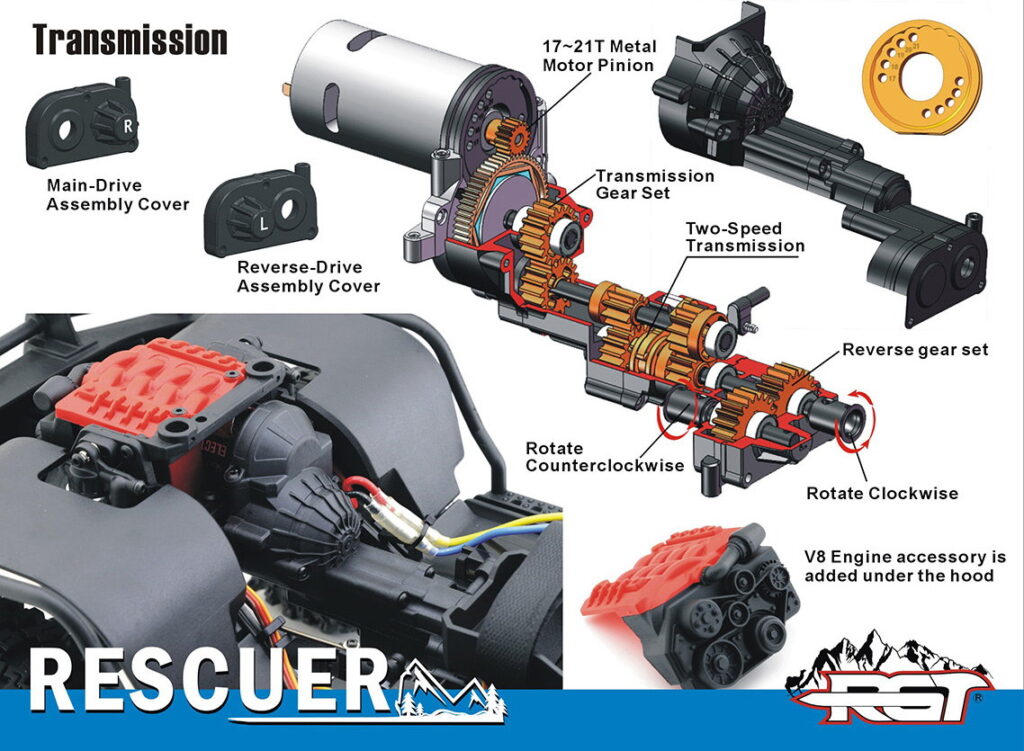
RGT Rescuer Axles
Portals
The EX86190 features portal axles, which serve to increase ground clearance and to gear-down the drivetrain. The front and rear diffs are remotely lockable and, as with the transmission, feature sealed ball-bearings throughout. The axle casings and portal casings are made of plastic and the diff cover is attached by 4 screws. If you open the diff for servicing, be sure to not over-tighten these screws in particular when reassembling!
Gears
Ring and pinion gears are straight-cut and “powder-alloy”. So, while they won’t be quite as strong as their TRX4 counterparts, they should stand up to abusive driving on a 2S battery and reasonably well even on 3S – depending on terrain, driving input and traction! For what it’s worth, we drove our unit beyond its intended design on our 6-problem rock course and suffered no breakages (we ran on 2S).
Lockers
The locking mechanism in the diffs looks identical to that of the TRX4 – a servo-actuated pivot piece, connected by cable back to the chassis-mounted servo. The pivot piece slides a dog (a ring with teeth on one side) along the axle shaft to engage and disengage with the differential casing. When locked, the diff gears can’t spin and so you have equal output to both wheels. When the dog is disengaged, the internal diff gears can spin, granting you differential rotation to each wheel. Independent control of each diff is granted by the radio’s Channels 5 and 6.
Links & Steering
Lastly, the axles feature a high-position link mount to help with clearing ground obstacles and the axles and portal outdrives are all metal. The front axle employs CVD (Constant Velocity Drive – allows a constant rotational speed regardless of angle) and have a maximum outer angle of 42 degrees and inner of 40 degrees. CVD isn’t as strong as a universal joint, but rotational output is smoother. In any case, the axles in the RGT Rescuer should be easily strong enough for intended use.
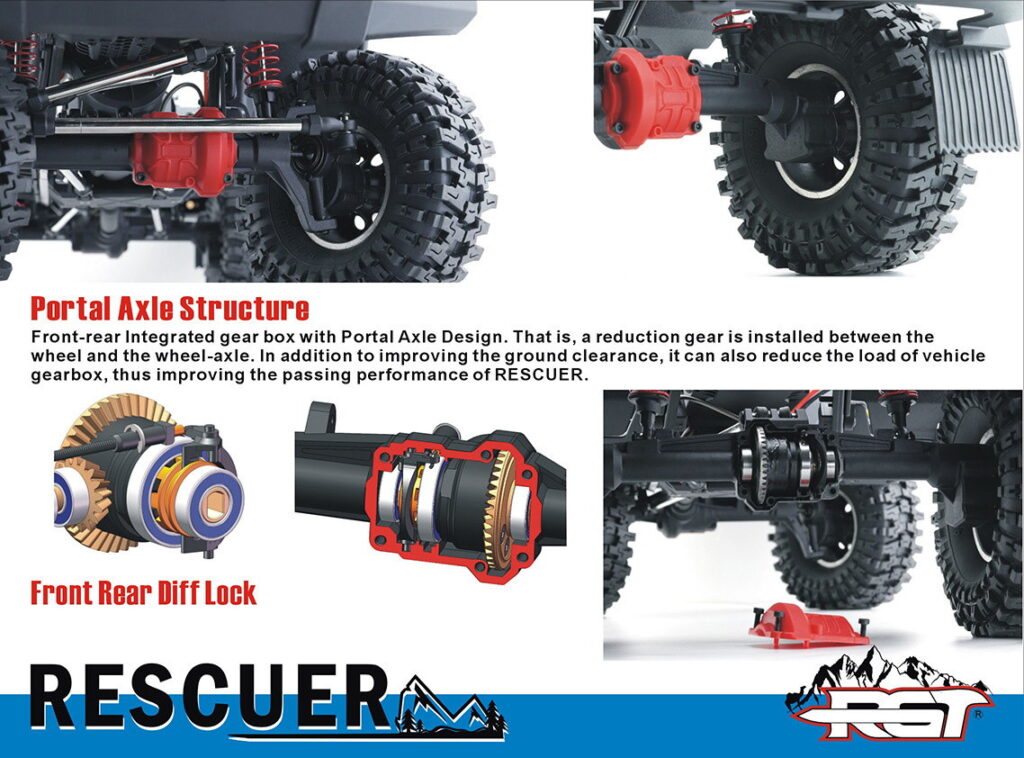
EX86190 Electronics
The RGT Rescuer has a 20-turn 550 motor, 4 servos, an ESC with built-in BEC and a radio system with built-in light kit:
Speed Controller
The Electronic Speed Controller is responsible for powering the motor, taking throttle inputs from the radio receiver. The ESC used here is the reliable Hobbywing WP-1060. This 60A Brushed ESC includes a 5V 2A BEC (Battery Eliminator Circuit) that powers the servos, radio system and lights. The ESC is waterproof and supports motors as low as 12-turn 540 3-pole on 2S and 18-turn 540 3-pole on 3S. Its power switch comes mounted to the side-board, facing down – you don’t have to remove the body to access it. It’s a solid device and well-suited to this vehicle.
Steering
The steering servo is a 25KG waterproof, metal-geared standard digital servo. It has ample torque and speed even on the 5V supply from the WP-1060. With the vehicle in its stock form, it’s certainly Good Enough.
Shifting
The three shifting servos are all waterproof, metal-geared, mini digital units. The 2-speed shifting servo is mounted back from the ESC, whilst the front and rear diff lock actuating servos are mounted on the other side of the chassis. Wiring is neatly routed in all cases and end-points came correctly adjusted from factory on our unit.
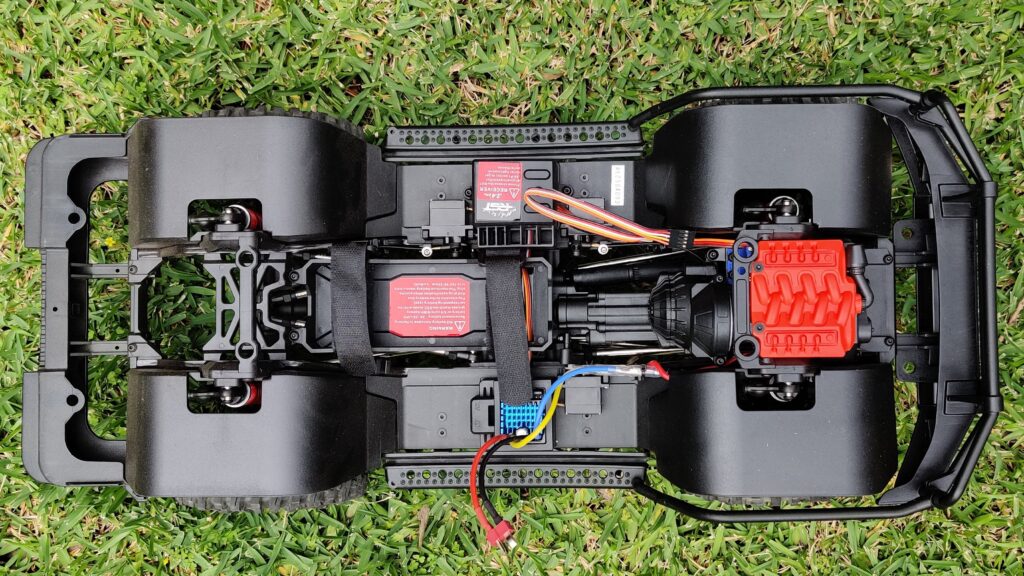
RGT X6P1 Radio System
Controller
RGT supplies a 6-channel radio system with the RGT Rescuer. It’s branded RGT X6P1 and appears to be a copy of the DumboRC X6 system – a lovely, full-featured, budget radio system. There’s a cheapish feel to the handset with all hard plastics and no rubber, but it’s comfortable in the hand and the construction is tidy with no sharp or uncomfortable edges.
Indicator Features
The buttons for Channels 3, 5 and 6 have LEDs built-in that light up when engaged, being 2-position electronic switches. The LED indicators are super handy on a model like this, as you can see at a glance if you’re in low or high gear and whether either of the front or rear diffs are locked or unlocked. Very nice!
Trim and End Points
Throttle and steering both have a smooth feel and are sprung just heavily enough for useful tactile resistance without making it tiring to use. Trim and end-point adjustment for these channels have dedicated dials on top, under a cover, whilst the other 4 channels can be adjusted per the user manual (a combo of key presses when powering on to set end points and trim – you shouldn’t need these if using the vehicle in stock form).
Batteries
The radio transmitter takes 4x AA batteries worked flawlessly in our testing. It’s a very nice radio and is well suited to the RGT Rescuer.
Channels & Lighting
The receiver has ports for 6 channels plus an extra for battery/power-only connection. It also features an additional set of ports for the integrated light controller, which is connected by a 5-wire cable to the light unit in the body. More on that below.
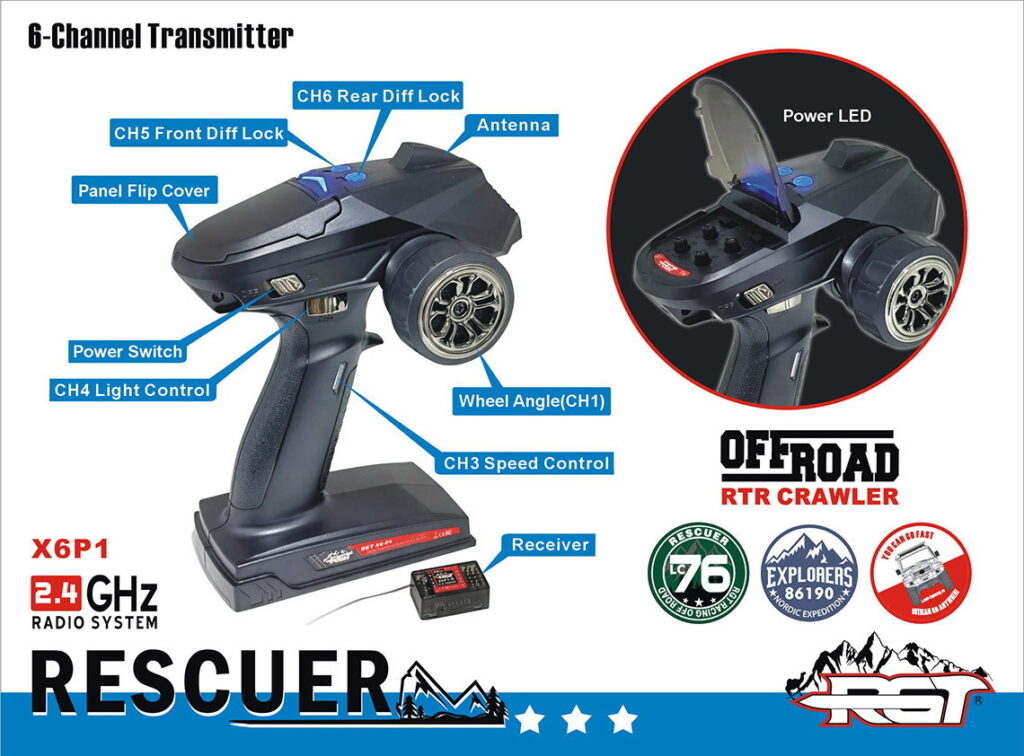
Light Me Up
It’s no exaggeration to say we wish all RC light kits worked as well as this one. The light kit is a dual-piece unit that is integrated with the RGT radio receiver. On the radio, Channel 4 is reserved as a three-position switch to control your lights. But it gets better: the light kit already has the wiring run inside the body for you to connect a light bar and/or the LEDs for those spotlights that are mounted but unpopulated by default. All wiring is routed neatly and it Just Works. Wonderful!
Here’s an outline of the light system:
- Light control module is connected in the body by a single 5-wire cable you connect when you mount the body.
- Indicators flash in the direction of your steering.
- Brake lights glow brightly when there’s no throttle input.
- Brake lights drop to ‘taillight’ level brightness when reversing or driving forward.
- Reverse lights glow brightly when you’re reversing.
- Headlights are:
- off with Channel 4 in position 0,
- flashing with Channel 4 in position 1, and
- glowing brightly with Channel 4 in position 2.
The system works smoothly and is a welcome detail that we’ve seen in all the RGT models we’ve tested over 2021 and 2022 so far. Lights are always welcome, but RGT has gone the extra mile with this functional light kit. Full marks for this!
Available Accessories
RGT makes a few optional extras to suit the RGT Rescuer. The faux light bar on the roof rack can be replaced with a functional unit (RGT P860077). Also, there’s a smaller light bar to fit the bull-bar (RGT P860079). The roof rack light bar can be connected to one of the spare power outlets from the light kit inside the body, whilst the bull-bar light bar can be connected to the spare 3-port plug on the receiver parallel to the 5-wire body connector plug.
There are also alloy wheels in two different designs to replace the stock plastic units: Design 1 (RGT P860065); Design 2 (RGT P860066). Both are bead lock wheels. RGT also has hub caps available to match the stock wheels (RGT P86162).
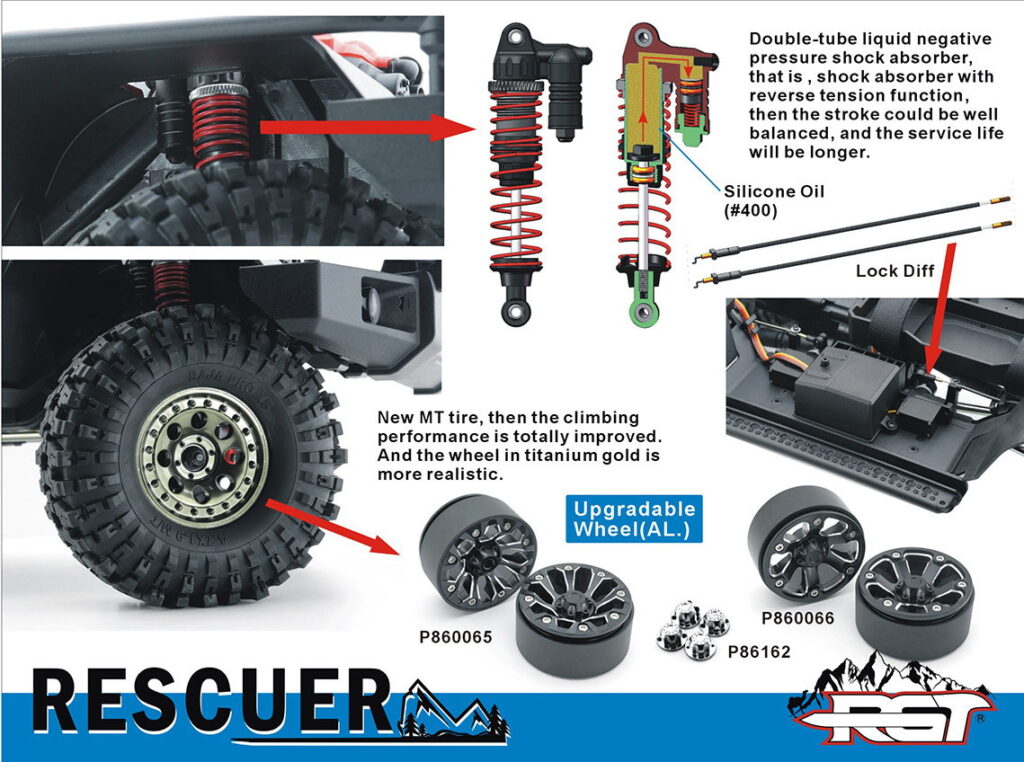
Performance
We’ve tested the RGT Rescuer on the trail and on the rocks. For a detailed look at how the truck goes on various surfaces, check out our two-part video review of this interesting machine (I’ve also now included a couple more videos we’ve since made).
More Info
Where To Buy It
The RGT Rescuer EX86190 can be purchased from RGT directly or from AsiaTees here. It’s only recently been released and its first run sold out quickly (Jan 2022). So, if it’s out of stock when you read this, hit ATees’ ‘NOTIFY ME’ button on the product page and you’ll be emailed when it’s back in stock.
To read more, visit the manufacturer’s site, here: rgt-racing.com.

Craig Veness
RC-TNT
Craig has been into radio control since the 90s and into RC crawling since about 2010, when a Losi MRC started the obsession! Now it’s all rocks this and crawl that and upgrade all the things! …You know how it is, right? Welcome home 🙂

